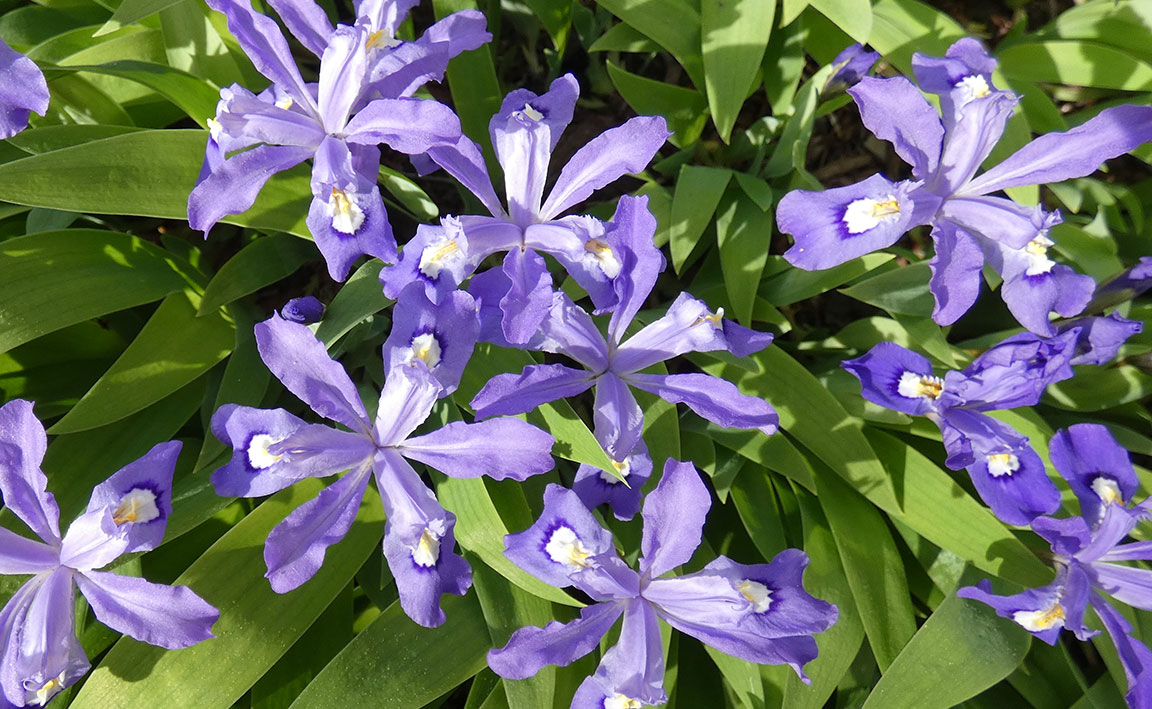
Maine Home Garden News — June 2022
In This Issue:
- June Is the Month to . . .
- A Gardener’s Balancing Act: Encouraging Pollinators and Managing Ticks
- Four Steps to Making Your Landscape Pollinator-Friendly
- June Maine Garden Harvest Guide
- Growing Wild Blueberries at Home
- Northern Flicker
- A Therapist’s Garden: Using Plants to Revitalize Your Spirit. by Erik Keller (Black Rose Writing, 2022)
June Is the Month to . . .
By Abi Griffith, UMaine Extension Horticulture Community Education Assistant
We wait long enough for the season to really kick off here in Maine. When June comes around, I think of:
- Seedlings! Early to mid-June is a great time to finish up getting transplants in the ground, especially your cold-susceptible tomatoes, eggplant, peppers, cucumbers, and squash. You are not behind. With the frost date most likely comfortably passed by, you can go for it! Even if you haven’t even started your garden yet, there is still time.
- Insects! You can help protect your crops from pests by covering all brassicas and cucurbits with row cover to protect from flea beetles and cucumber beetles. Once flowers are present on cucurbits, remove the row cover, so the pollinators can work their magic. Most brassicas can be left under a lightweight row cover all season long. Meanwhile, consider familiarizing yourself with Bulletin #7150: Beneficial Insects and Spiders in Your Maine Backyard.
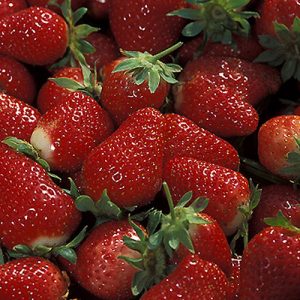 Strawberries! If you’re growing your own, here’s all you need to know, see Bulletin #2067: Growing Strawberries. If you don’t have your own, visit a pick-your-own strawberry operation for fresh berries. Eat fresh, or preserve/freeze to enjoy later. You can find a farm on the Get Real Get Maine website. Learn more in Bulletin #4036: Let’s Preserve Berries, and Bulletin #4039: Let’s Preserve Jellies, Jams, and Spreads.
Strawberries! If you’re growing your own, here’s all you need to know, see Bulletin #2067: Growing Strawberries. If you don’t have your own, visit a pick-your-own strawberry operation for fresh berries. Eat fresh, or preserve/freeze to enjoy later. You can find a farm on the Get Real Get Maine website. Learn more in Bulletin #4036: Let’s Preserve Berries, and Bulletin #4039: Let’s Preserve Jellies, Jams, and Spreads.
- Peonies! Stake peonies to support a heavy blossom set. Review the Kansas State publication, Peonies in the Garden, Kansas State University (PDF), for information on peony care. Extend the bloom season with tips in the article, “A Gardener’s Balancing Act: Encouraging Pollinators and Managing Ticks”.
- New Growth! Pinch herbs to encourage bushier growth or pluck tender sprigs or leaves of emerging seedlings. Add them to your salad or fancy up a drink.
- Irrigation! Consider installing an irrigation system or improving on an existing irrigation system. For more information on home garden irrigation, review UMaine Extension Bulletin #2160: Trickle Irrigation: Using and Conserving Water in the Home Garden.
- Ticks! Stay vigilant and get in the habit of frequent tick checks once you have been out in the garden or on trails. For information on submitting a specimen to the Tick Lab, as well as information on the different tick species of Maine, tick management, and personal protection, go to the UMaine Extension’s Tick Lab website.
- Seeds! Keep direct sowing and plan out repeat plantings for certain crops for a steady supply. Ornamental flowers, such as cosmos and zinnias, can also be directly seeded for a flush of color in sunny gardens.
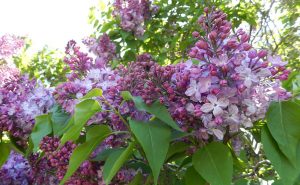 Lilacs! Once you have enjoyed your lilacs and they have finished flowering, this is the time to get in there and prune, before next year’s buds have formed. Review Bulletin #2169: Pruning Woody Landscape Plants, and scroll down for a video of how to prune a lilac. Don’t confuse yourself – this is only pruning time for spring-flowering trees and shrubs such as lilac, magnolia, flowering crabapple, and spirea if you want to not sacrifice already set buds. All other pruning should be done in late winter while the plants or trees are dormant.
Lilacs! Once you have enjoyed your lilacs and they have finished flowering, this is the time to get in there and prune, before next year’s buds have formed. Review Bulletin #2169: Pruning Woody Landscape Plants, and scroll down for a video of how to prune a lilac. Don’t confuse yourself – this is only pruning time for spring-flowering trees and shrubs such as lilac, magnolia, flowering crabapple, and spirea if you want to not sacrifice already set buds. All other pruning should be done in late winter while the plants or trees are dormant.
- Scapes! Pick garlic scapes off your hard neck garlic plants when they are still tender, to encourage bulb growth. Use them in cooking for a milder garlic flavor, marinate and throw them whole on the grill, make pesto, or even incorporate them into a flower arrangement. Watch the video, Garlic in the Home Garden: Removing Scapes (YouTube), for more information.
- Weeds! Weed early and often, with the proper tool. Using a collinear or stirrup hoe around new seedlings that aren’t mulched is an easy way to knock back any emerging weeds quickly before they become established, with minimal disturbance to the soil.
A Gardener’s Balancing Act: Encouraging Pollinators and Managing Ticks
By Lynne Holland, UMaine Horticulture and Social Media Professional and collaborators noted below.
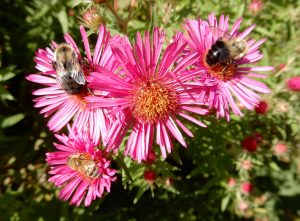 June is National Pollinator Month and pollinator-friendly garden practices are becoming more important as their populations continue to decline. It is also when people are spending more time outside and are concerned about tick exposure for themselves and their animals. However, being pollinator-friendly also means being insect-friendly, so when you create a good habitat for pollinators have you also created a tick haven? It’s a complicated question, so we asked some Cooperative Extension experts from Maine and New Hampshire:
June is National Pollinator Month and pollinator-friendly garden practices are becoming more important as their populations continue to decline. It is also when people are spending more time outside and are concerned about tick exposure for themselves and their animals. However, being pollinator-friendly also means being insect-friendly, so when you create a good habitat for pollinators have you also created a tick haven? It’s a complicated question, so we asked some Cooperative Extension experts from Maine and New Hampshire:
Are there strategies for creating a pollinator-friendly habitat that does not also attract ticks?
Nate Bernitz, UNH Extension Extension Program Manager: In my experience, encouraging a pollinator habitat in a discreet area does not necessarily run contrary to efforts in other parts of the yard to reduce tick habitat. Yes, you’ll see more dog ticks in areas with unmanicured herbaceous plants, but creating some pollinator-friendly habitat in the garden/yard doesn’t require rewilding your entire property. By understanding and taking inventory of the parts of your property that may function as tick habitat, you can be TickSmart without needing to eliminate that habitat. The overwhelming concern is around deer ticks which generally populate different habitats than what you find in the full sun, dry areas where many pollinator-friendly plants thrive.
Laurie Bowen, UMaine Community Education Assistant: I often ask folks to look at what their goals and concerns are and determine what is most important to them in how they use their space. I recommend homeowners consider all the information given and decide what is best for them based on their goals. The Pollinator-Friendly Garden Certification process is essentially an educational process. Even if a gardener chooses not to apply for garden certification there is a great deal to be learned from the website for those interested in creating pollinator habitats.
Marjorie Peronto, UMaine Extension Educator: I think that this dichotomy should be discussed openly so that people are aware of the benefits and drawbacks of creating wild areas in their landscapes. We can use a compromised approach, creating plantings that promote insect biodiversity in defined sections of our landscape and using strategies to minimize tick populations in the areas that are frequented by people. Just making the choice to incorporate native plantings, review (Bulletin #2500, Gardening to Conserve Maine’s Native Landscape: Plants to Use and Plants to Avoid) will build resiliency in your landscape, and using specific landscape management strategies will help keep tick habitat in check.
Rachel Maccini, Pesticide Safety Education Program Manager: Tick habitat can be anywhere there is the appropriate humidity, vegetation, and food source (hosts). These could be pollinator gardens. I think we should educate folks on tick prevention. The best way to avoid ticks is to use repellents when working around the garden and take breaks to check for ticks. Gardeners should wear bright clothing so it will be easier to spot a crawling tick. They should wear long sleeves and pants, and have socks pulled over pant legs to limit exposed skin to ticks (this is also a good idea to help limit sun exposure).
Griffin Dill, UMaine Integrated Pest Management Professional: It is always important to understand how the pollinator habitat is incorporated into the landscape. If this is an area where people will be spending time outdoors, then pollinator-friendly areas can pose an elevated risk. Keeping patios, swing sets, and picnic tables away from potential tick habitats will minimize that risk. Ultimately, personal protection is first and foremost in preventing exposure to ticks. A chemical barrier can be created through the use of repellents such as DEET, picaridin, and permethrin. Gardeners interested in protecting pollinator habitat while also trying to reduce tick numbers can target the small mammals that serve as primary tick hosts. This can be done through the use of a product known as tick tubes or through the placement of rodent bait boxes by a certified tick control company. Targeted application of low-risk pesticides, such as Met52 or essential oil-based products, can also be made while avoiding blooming flowers and timing sprays for early mornings or evenings when pollinators tend to be less active. While these products may pose a lower risk to pollinators there is a trade-off in efficacy against ticks.
Making a garden pollinator-friendly while keeping your property “people and pet” friendly appears to be a bit of a balancing act of conflicting priorities. In fact, it just takes patience and planning, but what garden doesn’t?
Four Steps to Making Your Landscape Pollinator-Friendly
By Laurie Bowen, Community Education Assistant Penobscot, and Piscataquis County
This is the time of year when we eagerly search for new blooms in our gardens, forests, and fields, and we are not the only ones! Our gardening colleagues, the pollinators, are savoring them too. How important is it for pollinators to have those blooms? After a long winter, pollen and nectar resources are essential for their continued survival. In turn, pollinators play a crucial role in ensuring that countless flowering plants are able to propagate themselves by seed and, for us, they play a key role in the development of many of our food crops. In fact, most of our vitamins and minerals are derived from insect-pollinated plants. It’s estimated that one in three mouthfuls of food and drink we consume are thanks to pollinators.
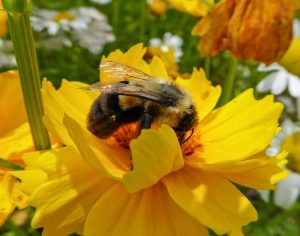 Pollinator numbers are declining in the face of habitat loss, climate change, and pesticide exposure. What can we do as individuals to help support these native pollinators? By supplying food, water, shelter, and protecting habitat, you can make a difference. Whether you have an established garden or are new to gardening we can all champion our diverse population of pollinators which, in Maine, include bees, wasps, flies, beetles, butterflies, moths, and hummingbirds.
Pollinator numbers are declining in the face of habitat loss, climate change, and pesticide exposure. What can we do as individuals to help support these native pollinators? By supplying food, water, shelter, and protecting habitat, you can make a difference. Whether you have an established garden or are new to gardening we can all champion our diverse population of pollinators which, in Maine, include bees, wasps, flies, beetles, butterflies, moths, and hummingbirds.
Wondering where to start? The Pollinator-Friendly Garden Certification program, developed in 2020, was established to educate the public on the importance of pollinators and offer practical steps to support them. Whether you are a novice gardener or have many seasons of experience, you’ll find useful tips to take action. The tips are organized into four steps outlined here.
Step 1:
Supplying food for pollinators gives insight into the importance of native plants of the Northeast, their role in our landscapes, and as larval hosts for butterflies and moths. Our newly revised application has a checklist of native species for each season to use as a guide. Links to a number of other inspiring plant lists are on our program page as well.
Pollinators need water for drinking, cooling, and reproduction and the different types of pollinators have diverse needs. For example, butterflies sip at shallow pools, mud puddles, and birdbaths and most insects need a landing pad, such as a rock or floating wood chip, in order to access deeper water resources.
Step 2:
You will get inspired on how to supply water for pollinators.
Nesting sites and overwintering sites are another necessity for pollinators.
Step 3:
Will introduce you to some very simple approaches to providing shelter. Postponing garden cleanup until spring, leaving dead wood behind, allowing space for some bare ground, or if you are feeling creative, making a bee box, all will assist them with little effort.
Step 4:
Will guide you through the steps to safeguarding your habitat. Eliminating pesticide use, controlling invasive plant species, and protecting native plants are all thoroughly explained in this step. Other conservation practices you can incorporate into your home garden are outlined as well.
In 2021, UMaine Cooperative Extension joined forces with UNH Extension to expand the program. Now, Maine and New Hampshire Master Gardener Volunteers not only review applications but also provide outreach to promote the program and support those interested in certifying or creating a pollinator-friendly garden space.
If you would like to further your efforts to support pollinators, consider certifying your garden as Pollinator-Friendly to help educate your community on the importance of pollinators. Private homeowners, community gardens, school gardens, municipalities, farms, and other organizations are all eligible to apply for certification.
For information on the program or the application process, please visit Pollinator-Friendly Garden Certification, email extension.pollinators@maine.edu or call Laurie Bowen at 207.942.7396.
June Maine Garden Harvest Guide
By Abigail Griffith, Community Education Assistant; David Handley, Small Fruit Specialist, and Kate Garland, Horticulture Professional
Reviewed by: Naomi Jacobs, Master Gardener Volunteer
Harvesting produce at its peak is the best way to achieve optimal flavor, shelf life, and overall quality. Additionally, many crops have improved yields if harvested in a timely manner. Determining the best time to harvest produce is not always intuitive, but can be simple with a little guidance. This season, we’ll offer practical crop-specific harvest tips for the home gardener each month. Additional growing information can be found in the resources linked to certain crops.
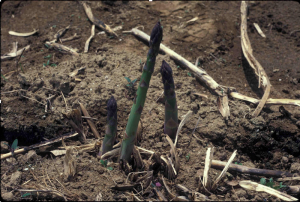 Asparagus: If you planted crowns this year, wait until the second year to harvest. Harvest spears when they reach 6 to 8 inches. Harvest all of them, even the skinny ones. Cut the spears at or just below the soil line. You can harvest every one to three days, depending on the temperature. It is recommended that you harvest for two weeks in the first harvest year, three weeks in the second harvest year, and four weeks in the third. In Maine, don’t harvest after about June 15th. These practices will promote fern growth that supports strong crowns and buds for next year’s crop. For more information see Bulletin #2071: Growing Asparagus in Maine.
Asparagus: If you planted crowns this year, wait until the second year to harvest. Harvest spears when they reach 6 to 8 inches. Harvest all of them, even the skinny ones. Cut the spears at or just below the soil line. You can harvest every one to three days, depending on the temperature. It is recommended that you harvest for two weeks in the first harvest year, three weeks in the second harvest year, and four weeks in the third. In Maine, don’t harvest after about June 15th. These practices will promote fern growth that supports strong crowns and buds for next year’s crop. For more information see Bulletin #2071: Growing Asparagus in Maine.
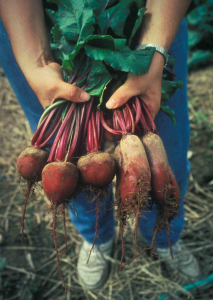 Beets: When harvesting for beet greens, pull the beets when the roots are about one inch in diameter, or, for continued harvest, trim leaves off individually when they reach the desired size. For best quality roots, harvest when they are about golf ball-sized, up to 2 or 3 inches.
Beets: When harvesting for beet greens, pull the beets when the roots are about one inch in diameter, or, for continued harvest, trim leaves off individually when they reach the desired size. For best quality roots, harvest when they are about golf ball-sized, up to 2 or 3 inches.
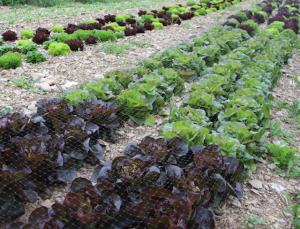 Lettuce: Romaine: If growing to harvest ahead, wait until the leaves have elongated and overlapped to form a fairly tight head, 8 to 10 inches tall. You can gently squeeze the head to test for the fullness. You may want to strip off the outer leaves on the head that can be very bitter.
Lettuce: Romaine: If growing to harvest ahead, wait until the leaves have elongated and overlapped to form a fairly tight head, 8 to 10 inches tall. You can gently squeeze the head to test for the fullness. You may want to strip off the outer leaves on the head that can be very bitter.
Bibb: Bibb lettuce is mature when the leaves have cupped inward to form a loose rosette. Gently squeeze the head to test for the fullness.
Leaf lettuce: Harvest leaf lettuce as mature open head lettuce, once the plant has fully filled out, or pinch off the outer leaves at any desired size over 4 inches or so.
Multiple harvests for “baby lettuce” or cut and come again: For continuous harvests of quick and easy salad greens, sow a bed thickly with a mixture of your favorite salad greens (choosing those with similar maturity dates). Use scissors, a knife, or your fingers to remove leaves about 1.5 inches above the ground. Make sure you do not cut off the apical meristem, ensuring regrowth. These lettuces will quickly re-grow if watered and fertilized and can be cut a second time 2-3 weeks later. Then sow a second bed. Turn under the plants when they become overly mature and bitter.
 Radish: Harvest salad radishes at the desired size, usually one to 1½ inches, with reference to your variety’s ‘days to maturity.’ If allowed to grow bigger the roots are susceptible to cracking and may get woody. It is best to seed radishes every two weeks to keep a fresh supply throughout the spring.
Radish: Harvest salad radishes at the desired size, usually one to 1½ inches, with reference to your variety’s ‘days to maturity.’ If allowed to grow bigger the roots are susceptible to cracking and may get woody. It is best to seed radishes every two weeks to keep a fresh supply throughout the spring.
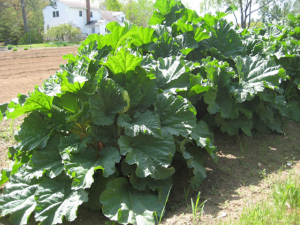 Rhubarb: Wait until the second season to harvest from new transplants. Harvest no more than half of the stalks of a plant once they are the desired size. Waiting until they are a little taller and thicker may improve quality and give you more to eat. Harvest as much as desired for the first half of the summer, leaving the plant alone after mid-July. Harvest by pulling firmly and twisting from the base of the stalk or cutting near the base. Remove the leaves and discard them. Remove flower stalks as they appear to improve leaf stalk quality and extend the harvest.
Rhubarb: Wait until the second season to harvest from new transplants. Harvest no more than half of the stalks of a plant once they are the desired size. Waiting until they are a little taller and thicker may improve quality and give you more to eat. Harvest as much as desired for the first half of the summer, leaving the plant alone after mid-July. Harvest by pulling firmly and twisting from the base of the stalk or cutting near the base. Remove the leaves and discard them. Remove flower stalks as they appear to improve leaf stalk quality and extend the harvest.
For more information see Bulletin #2514: Growing Rhubarb in Maine.
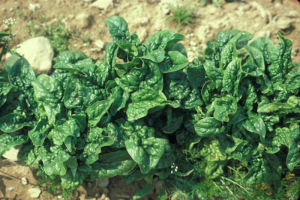 Spinach: Harvest dark green, tender leaves from 3 to 6 inches by picking or cutting individual leaves. Start with the outer leaves, and then harvest newer leaves as they reach your desired size.
Spinach: Harvest dark green, tender leaves from 3 to 6 inches by picking or cutting individual leaves. Start with the outer leaves, and then harvest newer leaves as they reach your desired size.
Swiss Chard: Chard can be harvested when young and tender, or all the way up to maturity when plants reach 1 to 2 feet. Harvest the outer leaves at the desired size by cutting or breaking the stem of the leaf near the base. Chard can be picked throughout the season, continuously, until frost.
Turnips: Harvest turnips at approximately 1.5 to 2.5 inches in diameter, otherwise the flesh of the turnip can be woody. Don’t forget you can eat the greens too.
Growing Wild Blueberries at Home
By Lily Calderwood, Ph.D., UMaine Extension Wild Blueberry Specialist, and Mara Scallon, Research Assistant, Lowbush Blueberry Research and Extension Program, University of Maine.
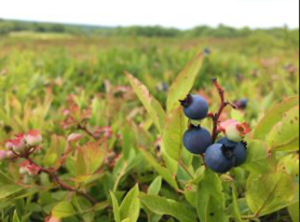 Living in Maine offers a range of benefits, stretching from the coasts to the mountaintops to the riversides. One of the most delicious benefits comes in the form of the wild (lowbush) blueberry plant, which is a native and naturally occurring plant in the landscape. Because wild blueberries thrive in Maine it is likely that you already have them in your backyard or could transplant wild blueberries from one location to your equally suitable backyard. This fact sheet is for Mainers looking to foster their own wild blueberry plants at home.
Living in Maine offers a range of benefits, stretching from the coasts to the mountaintops to the riversides. One of the most delicious benefits comes in the form of the wild (lowbush) blueberry plant, which is a native and naturally occurring plant in the landscape. Because wild blueberries thrive in Maine it is likely that you already have them in your backyard or could transplant wild blueberries from one location to your equally suitable backyard. This fact sheet is for Mainers looking to foster their own wild blueberry plants at home.
Establishing a new wild blueberry patch
Location
Wild blueberries live in acidic, very well-draining coastal and mountain top locations. Sometimes it seems that wild blueberries grow everywhere in Maine but in order to foster them on your own land, you will need the right conditions because this plant has never been bred for attributes that would make it easier to cultivate. Wild blueberries will not grow well in a garden box, planter, or grown with annual vegetables or other perennial berry bushes. A separate, specific location that provides slightly acidic, well-drained, sandy soil with ample room for the blueberry plant to grow horizontally, while maximizing daily sun exposure will improve the likelihood of successful wild blueberry harvests. These locations may not necessarily be found in the specific place where you would prefer to have wild blueberries, such as close to your house.
Soil
It’s important to plant wild blueberries in well-drained soils, like sandy soils. Do not plant wild blueberries in clay soils. Identify your soil pH by taking a soil sample.
Apply sulfur to decrease the soil pH to 4.0 – 4.5; see wild blueberry fact sheet #254, Soil pH Management for recommendations on applying sulfur. Note that sulfur should not be applied when the ground is frozen or saturated with water or when your wild blueberry leaves are wet as you could burn the wild blueberry leaves.
To sample your soil, pick up a soil sample box and form from your local University of Maine Cooperative Extension County Office, or from the Analytical Lab and Maine Soil Testing Service. Call 207.581.3591. Some garden centers may carry them as well.
Using a trowel or small shovel and bucket, head to the location you’d like to plant wild blueberries and gather multiple samples of soil by digging a few small holes three to six inches deep. Repeat ten times minimum, then mix these soil samples together in a bucket and use the resulting mixture to fill a soil sample box. Mail the box and soil sample form to the Maine Soil Testing Lab in Orono with payment. Please send a check or money order to cover the cost of the analysis. For additional information on testing your soil, see Bulletin #2286: Testing Your Soil.
VIDEO: Soil Testing at the University of Maine (YouTube)
Transplanting
When buying blueberry sod be sure to choose a reputable nursery. Sod is cut from old wild blueberry patches or fields in Maine and usually comes in 1ft. x by 1ft., 3-inch thick blocks.
Transplant the sod in the desired location. Wild blueberries can be planted as separate plants, in rows, or mixed in with other plants. Wild blueberries need full sunlight to grow best so you may need to prune nearby plants to maximize exposure to sunlight.
For the first two years of growth, you want wild blueberries to put their energy into re-establishing strong roots, so you must pinch off all blossoms for those first two seasons. Painful as this is to do, it will improve the long-term health of wild blueberries substantially.
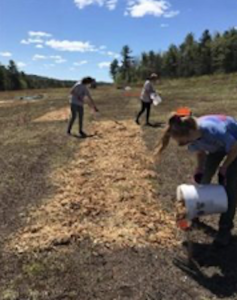 Mulch
Mulch
Apply softwood mulch among sod pieces and in between blueberry stems. This adds organic matter and holds moisture, aiding in wild blueberries’ root development. Softwood mulch is a good choice because it is already a lower pH material and it is readily available in Maine.
Water
Water or irrigate in the first two years so wild blueberries can re-establish well in a dry season. Wild blueberries need approximately one inch of water per week. If watering, don’t provide this water all at once – space it out over the course of the week. If there is adequate rainfall, there is no need to add supplemental water as this can cause disease.
Encouraging an existing wild blueberry patch
Mowing
Mow the wild blueberry patch every other fall (October through November) to 1.5-inch height. To mow, you can use a lawnmower, power trimmer, or flail mower on the lowest setting. Don’t worry, 75% of the plant is underground so you will not hurt the plants. Wild blueberries need to be mowed in order to produce berries in the quantities we want them to.
If you want to produce berries every single year, you’ll need to develop a two-year production cycle. Split your patch in half (approximately) and mow one half of the patch at the end of the season (in October through November), using a lawnmower, electric trimmer, or flail mower). Leave the other half of the patch un-mowed. In the spring, you will see that your mowed patch begins to grow stems and buds and as the season progresses, the stems will grow taller but you will not see any berries. This is known as the “prune year” and the goal is vegetative growth for next year’s berry harvest. The side that was not mowed will produce berries. During the fall after picking the berries, mow this side to produce berries in two years. In short, you will mow half of your patch every year, alternating sides. Berries will be produced every year but on alternating patches.
Burning blueberry plants is another way of pruning the plant, however, this is not recommended for homeowners due to safety reasons.
Water
Wild blueberries need approximately one inch of water per week in both the prune and crop years. If it doesn’t rain frequently, ensure your plants are receiving enough water.
Manage weeds
Maintaining a soil pH between 4.0 and 4.5 reduces competition from grasses and broadleaf weeds. For more information about applying sulfur to maintain acidic soil pH see wild blueberry fact sheet on Weeds. For woody tree saplings (e.g. birch, willow, alder) and ferns (e.g. sweet, bracken), cutting is the best management option. Cut these saplings and ferns to the ground three times each year. The goal is to let the plant put energy into above-ground vegetative growth and then cut it away. Cut the undesired plant in early summer when it has fully leafed out, let the plant grow back again, cut it again, and repeat until the plant stops growing.
General best practices
Fruit harvest and storage
The easiest way to harvest the blueberries is by either hand-picking a small plot or using a metal hand rake for a larger plot. Homeowners can expect yields of approximately half a pound per square foot once the plant is well established, which usually occurs after four years of good management. As with all fruit, wash the berries before consuming them, and store harvested berries in an open container within your kitchen’s refrigerator to extend the berries’ shelf life. Be sure to enjoy the bounty of your harvest in a range of recipes!
Encourage pollinators!
Wild blueberries are pollinated by many native bee species and managed honey bee hives. Entice pollinators to come to your wild blueberries by planting pollinator-friendly plants that bloom throughout the season. Consider how your use of certain pesticides might adversely impact pollinator populations. For more information, review Bulletin #7153: Understanding Native Bees, the Great Pollinators: Enhancing Their Habitat in Maine.
Sunlight
Wild blueberries grow best in full sunlight. If other plants are shading your wild blueberries, you may need to prune or move those plants. Wild blueberry stems will tilt towards the sun when they do not have enough light.
Fertilizer
Keep in mind, that fertilizers can feed weeds just as much as wild blueberries so fertilizing is not always needed. Conventional fertilizers for acidic plants contain soluble ammonium sulfate, which allows nutrients to be taken up in the acidic wild blueberry soils. Organic gardeners will want to use products for plants requiring acidic conditions such as those marketed for blueberry and rhododendron.
Troubleshooting
If the plants are not growing or bearing well, start by looking at the following:
- Soils: are they acidic (4.0 – 4.5 pH) and well-drained?
- Sunlight: is there enough?
- Water: is there enough?
For more information:
Lily Calderwood
Wild Blueberry Specialist and Assistant Professor of Horticulture
University of Maine Cooperative Extension
lily.calderwood@maine.edu
207.812.2915
Northern Flicker
By Doug Hitchcox, Maine Audobon Staff Naturalist
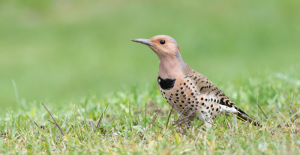
Perhaps one of the most striking North American woodpeckers, the Northern Flicker is a year-round resident of Maine woodlands, and as temperatures rise you can expect to come across this bird more frequently. Flickers spend most of their time foraging for ants and beetles, fitting their specially-adapted curved bill into hard-to-reach spots. This distinctly patterned woodpecker has a polka-dot covered breast with notable black and red shapes around its face and chest. The Northern Flicker uses drumming (a mechanical noise) instead of vocalizing to proclaim its territory, a common behavior amongst woodpeckers. Woodpeckers will find objects to drum on that will create the loudest noise possible, usually a hollow dead tree, but sometimes metal signs or telephone poles. If it has discovered the right material, a flicker can be heard from at least half a mile away.
For more on the importance of Maine native plants to support birds and other wildlife, visit Maine Audubon’s “Bringing Nature Home” webpage.
A Therapist’s Garden: Using Plants to Revitalize Your Spirit. by Erik Keller
(Black Rose Writing, 2022)
Reviewer: Colleen E. Griffin, Registered Horticultural Therapist and Master Gardener Volunteer in Oxford/Cumberland County
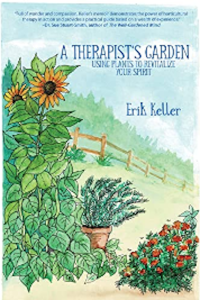 A Therapist’s Garden: Using Plants to Revitalize Your Spirit, is part memoir, part garden reference, and a firsthand account of the healing power of nature. The author, Erik Keller, is a registered horticultural therapist and master gardener with 20 plus years of experience working with people of all ages who are coping with physical, emotional, and mental challenges. Erik’s work has taken him into prisons, schools for special needs students, nursing care facilities, and private homes. He currently manages the gardens and horticultural therapy program at Ann’s Place in Danbury, CT, an organization that assists cancer patients and their families. Erik is also a Conservation Commissioner in the town of Ridgefield, CT.
A Therapist’s Garden: Using Plants to Revitalize Your Spirit, is part memoir, part garden reference, and a firsthand account of the healing power of nature. The author, Erik Keller, is a registered horticultural therapist and master gardener with 20 plus years of experience working with people of all ages who are coping with physical, emotional, and mental challenges. Erik’s work has taken him into prisons, schools for special needs students, nursing care facilities, and private homes. He currently manages the gardens and horticultural therapy program at Ann’s Place in Danbury, CT, an organization that assists cancer patients and their families. Erik is also a Conservation Commissioner in the town of Ridgefield, CT.
For the master gardener volunteer or anyone who has an interest in horticultural therapy, this book will both inform and entertain. Each chapter relays a unique story of the season, the garden, and people-plant interactions, which is at the very core of horticultural therapy. Beginning in January and ending in December, Erik Keller takes the reader on a journey of therapeutic activities and practical gardening methods. From flower arranging to propagation, and sowing seeds to harvesting produce, each month offers a plant-centric activity intended to enliven all five senses. Along the way, wonderous and endearing stories are shared as Erik interacts with the children, elderly, and young adults he works with.
Throughout the book, common names of plants are used, and the Latin name of each is also included within parenthesis. Included at the end of the book is an index of plant names, listing the common name beside the Latin name. In the month of February, a group of elders arrange flowers into “tussie mussies” and learn about the secret language of flowers. On page 19 in this chapter a list of the meanings of flowers is included; a good resource that can be used in your own activity. The reader will learn how to create a ‘wild’ salad in May’s chapter, and in September, you will learn about infused vinegar. A list of edible wild plants is offered as well as a word of caution about identifying each species.
A Therapist’s Garden: Using Plants to Revitalize Your Spirit is a wonderful resource for those who want gardening to be more than a chore. Slowing down and paying attention to the sights, smells, sounds, tastes, and textures will uncover hidden benefits in any garden. Horticultural therapists are adept at using plants and gardening activities as therapeutic tools for the reduction of stress and to improve well-being. Erik Keller methodically takes the reader through the horticultural year offering a perspective that will delight, educate, and entertain
Do you appreciate the work we are doing?
Consider making a contribution to the Maine Master Gardener Development Fund. Your dollars will support and expand Master Gardener Volunteer community outreach across Maine.
Your feedback is important to us!
We appreciate your feedback and ideas for future Maine Home Garden News topics. We look forward to sharing new information and inspiration in future issues.
Subscribe to Maine Home Garden News
Let us know if you would like to be notified when new issues are posted. To receive e-mail notifications, click on the Subscribe button below.
University of Maine Cooperative Extension’s Maine Home Garden News is designed to equip home gardeners with practical, timely information.
For more information or questions, contact Kate Garland at katherine.garland@maine.edu or 1.800.287.1485 (in Maine).
Visit our Archives to see past issues.
Maine Home Garden News was created in response to a continued increase in requests for information on gardening and includes timely and seasonal tips, as well as research-based articles on all aspects of gardening. Articles are written by UMaine Extension specialists, educators, and horticulture professionals, as well as Master Gardener Volunteers from around Maine. The following staff and volunteer team take great care editing content, designing the web and email platforms, maintaining email lists, and getting hard copies mailed to those who don’t have access to the internet: Abby Zelz*, Annika Schmidt*, Barbara Harrity*, Cindy Eves-Thomas, Kate Garland, Mary Michaud, Michelle Snowden, Naomi Jacobs*, Phoebe Call*, and Wendy Roberston.
*Master Gardener Volunteers
Information in this publication is provided purely for educational purposes. No responsibility is assumed for any problems associated with the use of products or services mentioned. No endorsement of products or companies is intended, nor is criticism of unnamed products or companies implied.
© 2022
Call 800.287.0274 (in Maine), or 207.581.3188, for information on publications and program offerings from University of Maine Cooperative Extension, or visit extension.umaine.edu.
The University of Maine is an EEO/AA employer, and does not discriminate on the grounds of race, color, religion, sex, sexual orientation, transgender status, gender expression, national origin, citizenship status, age, disability, genetic information or veteran’s status in employment, education, and all other programs and activities. The following person has been designated to handle inquiries regarding non-discrimination policies: Director of Equal Opportunity, 101 North Stevens Hall, University of Maine, Orono, ME 04469-5754, 207.581.1226, TTY 711 (Maine Relay System).
